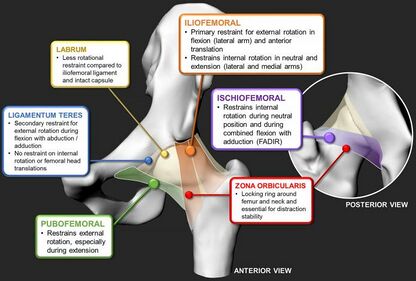Ischiofemoral Ligament: Difference between revisions
Mohit Chand (talk | contribs) No edit summary |
Mohit Chand (talk | contribs) No edit summary |
||
| Line 15: | Line 15: | ||
</ref> | </ref> | ||
{{#ev:youtube|zyqiRs4MnzA}} | |||
== Clinical Relevance == | == Clinical Relevance == | ||
Revision as of 16:03, 21 March 2024
Original Editor - Mohit Chand
Top Contributors - Mohit Chand
Introduction[edit | edit source]
The hip joint is reinforced by three primary fibrous capsular ligaments, including the ischiofemoral ligament, which plays a crucial role in stabilizing the joint. [1]This ligament, along with the iliofemoral and pubofemoral ligaments, contributes to the overall stability and function of the hip joint.
Attachments[edit | edit source]
 The ischiofemoral ligament is the weakest of the three hip ligaments and consists of a triangular band of fibers that attach to the ischium behind the acetabulum and the base of the greater trochanter.
The ischiofemoral ligament is the weakest of the three hip ligaments and consists of a triangular band of fibers that attach to the ischium behind the acetabulum and the base of the greater trochanter.
Function[edit | edit source]
The ischiofemoral ligament restricts internal rotation of the hip joint, particularly in relation to hip flexion angles. Studies have shown that this ligament, along with the iliofemoral ligament, plays a significant role in preventing excessive internal hip rotation and maintaining joint stability.[2]
Clinical Relevance[edit | edit source]
Injuries to the ischiofemoral ligament can occur in dislocations, leading to lesions of the foveal artery and potentially resulting in osteonecrosis of the femoral head.
References[edit | edit source]
- ↑ Ng, K. C. G., Jeffers, J. R. T., & Beaulé, P. E. (2019). Hip Joint Capsular Anatomy, Mechanics, and Surgical Management. The Journal of bone and joint surgery. American volume, 101(23), 2141–2151.
- ↑ Baba K, Chiba D, Mori Y, Kuwahara Y, Kogure A, Sugaya T, Kamata K, Oizumi I, Suzuki T, Kurishima H, Hamada S, Itoi E, Aizawa T. Impacts of external rotators and the ischiofemoral ligament on preventing excessive internal hip rotation: a cadaveric study. J Orthop Surg Res. 2022 Jan 4;17(1):4. doi: 10.1186/s13018-021-02873-w. PMID: 34983573; PMCID: PMC8725321.






